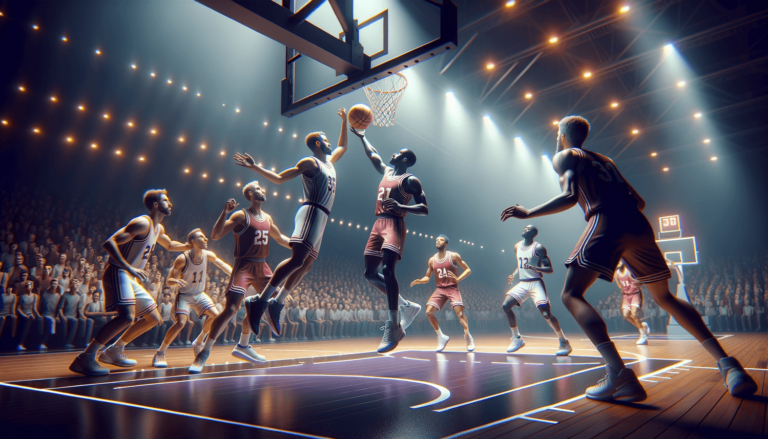
When it comes to the game of basketball, terms and strategies abound for players and enthusiasts to explore. One such term, ‘cherry picking’, might raise questions for those eager to dive deeper into the sport’s tactics. In this blog post, we’ll peel back the layers of this intriguing term, delving into its origins, significance, and eventual impact on today’s game. So, whether you’re a curious newbie or a seasoned fan, get pumped as we uncover the ins and outs of cherry picking in the world of basketball!
What Does Cherry Picking Mean in Basketball?
Cherry picking in basketball refers to a player positioning themselves near the opponent’s basket, often during a defensive play, in anticipation of making an easy, uncontested shot. This strategy relies on the player’s teammates rebounding the ball and quickly passing it down the court to capitalize on the cherry picker’s advantageous position.
An Introduction to Cherry Picking in Basketball
Cherry picking is a unique yet controversial tactic within the world of basketball. Though sometimes frowned upon for its opportunistic nature, it remains an interesting feature of play that some coaches and players choose to utilize. In this blog post, we’ll take an in-depth look at the concept of cherry picking to help you understand its role in the game, how it works, and the pros and cons of implementing this tactic. Let’s dive in!
How Cherry Picking Works
Cherry picking essentially involves a player focusing on offense while disregarding their defensive responsibilities. By remaining near the opponent’s basket during defensive play, this player (the cherry picker) seeks to place themselves in a prime position for receiving a long pass and subsequently scoring an easy basket.
Execution of Cherry Picking
For cherry picking to succeed, several factors need to align. First, the defensive team (including the cherry picker) must secure a rebound or steal. Once this occurs, the cherry picker’s teammates must promptly send a long pass down the court to the player who has been strategically positioned near the opponent’s basket. Finally, the cherry picker needs to complete the fast break by successfully scoring a basket.
Cherry Picking on Defense and Offense
Cherry picking can take place during both defensive and offensive plays. When executed defensively, the cherry picker aims to score swiftly after their team gains possession of the ball. On the other hand, when cherry picking offensively, the player seeks out an easy basket by remaining near the opponent’s hoop while their teammates create a diversion elsewhere on the court. Although cherry picking is more commonly associated with defensive play, its potential benefits in both scenarios can make it a tempting tactic for many players.
The Pros and Cons of Cherry Picking
As with any basketball strategy, cherry picking has its own distinct advantages and disadvantages. Weighing the pros and cons of this technique can help coaches and players decide whether it is a worthwhile addition to their game plan.
Advantages of Cherry Picking
- Increased Scoring Opportunities: Executing cherry picking effectively can contribute to fast break points, as the cherry picker positions themselves close to the opponent’s basket for easy scoring opportunities.
- Defensive Chaos for the Opponent: The opposing team may become flustered or frustrated, knowing that a cherry picker is lurking near their hoop. This pressure can create additional mistakes and turnovers, giving the team implementing cherry picking even more chances to score.
- Less Defense Needed: A successful cherry picker might reduce the need for their team to play strong defense if they can consistently score off of fast breaks initiated by cherry picking.
Disadvantages of Cherry Picking
- Defensive Vulnerability: By cherry picking, a player eschews their defensive duties in hopes of securing easy points. Consequently, their team is left short-handed on defense, which can be detrimental to overall game performance.
- Unreliability: Relying on cherry picking as a tactic is risky, as it depends on other factors like successful rebounds or steals and accurate long passes. There is no guarantee of these occurrences, rendering the strategy unreliable.
- Perception of Poor Sportsmanship: Some players, coaches, and fans view cherry picking as a cheap or unsportsmanlike way to score. In some cases, its use can lead to animosity or friction between teams.
Examples of Cherry Picking in Action
Throughout the history of basketball, certain players have become synonymous with the cherry picking tactic. A few examples include:
Wilt Chamberlain
Legendary basketball player Wilt Chamberlain was known to employ cherry picking on occasion. With his impressive height and athleticism, Chamberlain was able to capitalize on easy points by catching long passes and scoring with ease.
Rickey Green
Former NBA player Rickey Green gained notoriety for his cherry picking skills as a point guard. His quickness and ability to read the game made him an effective cherry picker, allowing Green to score countless fast break points.
Cherry Picking in the Modern Basketball Era
Cherry picking remains a contentious issue in contemporary basketball, with many coaches and players considering the tactic either outdated or unsportsmanlike. Nevertheless, some elements of cherry picking can still be found in certain game situations or employed by specific teams and players.
Cherry Picking in Youth Basketball
Cherry picking is more prevalent in youth basketball, where coaches may encourage its use to develop fast break skills and create scoring opportunities for their team. However, critics argue that focusing on cherry picking during formative years might hinder the development of other crucial basketball skills, such as defensive positioning and overall court awareness.
Cherry Picking in Professional Basketball
Professional basketball often sees less blatant cherry picking than what occurs in lower levels of the game. Nevertheless, certain players might be seen cherry picking occasionally, whether through exploiting opportunities that arise or even testing a team’s adaptability during a game.
Debate Surrounding Cherry Picking in Basketball
As previously mentioned, cherry picking is a divisive topic within the basketball community. While some embrace this tactic for the potential advantages it offers, others reject it on the grounds of sportsmanship and defensive integrity.
Cherry Picking: A Valid Tactic or Unsportsmanlike Conduct?
Proponents of cherry picking contend that the technique is a legitimate and strategic method of gaining an advantage on the court. They argue that as long as the tactic abides by the established rules of basketball, it is valid and can be employed to help secure victory. Critics, however, assert that cherry picking detracts from the essence and spirit of basketball, which involves players engaging in both offense and defense. Furthermore, detractors maintain that relying on cherry picking is a form of poor sportsmanship, as it seeks to exploit loopholes in the game rather than improve one’s skills or teamwork.
Does Cherry Picking Belong in the Modern Game?
The relevance of cherry picking in modern basketball is constantly under debate. Some coaches believe cherry picking can be advantageous if used strategically and sparingly, while others feel it is a dying tactic that no longer holds a place in the rapidly evolving game. The discourse surrounding cherry picking remains ongoing and is an intriguing aspect of basketball discussions amongst players, coaches, and fans alike.
Conclusion: Enduring Appeal of Cherry Picking
Despite the controversies and hotly contested debate surrounding cherry picking, it remains a notable part of basketball’s lexicon and history. As the game continues to evolve and tactics rise and fall from favor, cherry picking is sure to be a subject of discussion for years to come. Ultimately, players and coaches must determine whether to embrace this strategy or opt for other, more conventional methods to achieve their on-court objectives.
Developing Counter Strategies for Cherry Picking
Given the divisive nature of cherry picking, it’s crucial for teams to have counter strategies in place to minimize its potential impact. Whether you’re a coach or a player, understanding how to defend against cherry picking can help maintain a balance between offense and defense on the court.
Effective Communication and Court Awareness
One of the best ways to counter cherry picking is by ensuring consistent communication on the court. Teammates should be vocal and inform each other of a potential cherry picker’s location. Additionally, fostering court awareness helps players maximize their capacity to pick up on cherry-picking attempts and alter their defensive approach accordingly.
Utilizing Full-court Press
Implementing an effective full-court press can disrupt a cherry picker’s plans. By applying pressure on the opponent’s ball handlers and making it difficult for them to execute a long pass, you can reduce the cherry picker’s chances of receiving the ball or scoring an easy basket.
Assigning a ‘Safety’ Player
When facing a team known to employ cherry picking, consider assigning a player as a ‘safety’ to alleviate potential consequences. A safety player’s responsibility is essentially to act as a last line of defense, specifically focusing on marking the cherry picker and preventing them from capitalizing on any easy baskets.
Cherry Picking Variations and Alternatives
While cherry picking is a distinct tactic within basketball, several variations and alternative strategies share similarities with its underlying concepts. Familiarizing yourself with these related approaches can provide insight into the broader context of basketball tactics.
The Fast Break Attack
A fast break is an offensive strategy typically initiated after a defensive rebound, steal, or blocked shot. The goal is to rapidly move down the court and create easy scoring opportunities before the opposing team can set up a robust defense. While the fast break shares some elements with cherry picking — primarily in terms of the quick transition between defense and offense — it is a more widely accepted and respected tactic in basketball.
Leak-out Player
A leak-out player is similar to a cherry picker but involves a more subtle approach. Instead of blatantly ignoring their defensive duties, a leak-out player will start to transition from defense to offense slightly earlier than their teammates, seeking to gain an advantageous position on the court. While this tactic may also be deemed controversial, it is often viewed as a less flagrant infringement on the principles of basketball than cherry picking.
Cherry Picking’s Legacy and Future
While the perception and prevalence of cherry picking in basketball have certainly evolved over time, its tactical influence on the game cannot be denied. As teams continue to adapt to various strategies and exploit opportunities to score, the ongoing discourse regarding cherry picking highlights the dynamic nature of basketball as a sport. Whether or not its usage will persist or wane in the coming years, cherry picking will undoubtedly remain an intriguing subject for basketball enthusiasts to ponder.
Frequently Asked Questions
This FAQ section addresses some of the most common questions and concerns semantically related to cherry picking in basketball. Dive into these queries to gain an even deeper understanding of this intriguing and contested tactic.
1. Is cherry picking considered cheating in basketball?
Cherry picking is not considered cheating, as it doesn’t break any official basketball rules. However, it can be seen as unsportsmanlike or frowned upon by some players, coaches, and fans due to its exploitative nature.
2. Why isn’t cherry picking more prevalent in professional basketball?
In professional basketball, cherry picking is less prevalent because players and coaches prioritize strong defensive play and overall court awareness. Additionally, cherry picking may be perceived as unprofessional or as a sign of poor sportsmanship at higher levels of the game.
3. Can cherry picking be used in all basketball leagues?
There are no specific league-wide rules barring cherry picking; however, individual coaches and teams may discourage its use based on their own strategic preferences or principles. Generally, cherry picking is more accepted in lower-level leagues, such as youth basketball.
4. How can I perfect the cherry-picking technique?
To perfect the cherry-picking technique, focus on enhancing your speed, court awareness, anticipation, and positioning. Strengthening your ability to catch long passes and finish fast breaks with precision is also key to effective cherry picking.
5. What is the difference between a fast break and cherry picking?
A fast break is a legitimate offensive tactic initiated after a defensive rebound, steal, or blocked shot. The goal is to create scoring opportunities before the opponent’s defense is set. Cherry picking, on the other hand, involves a player blatantly disregarding defense in favor of positioning themselves for easy basket opportunities. While both tactics aim for fast scoring, cherry picking is often frowned upon due to its unsportsmanlike implications.
6. Are there any famous professional basketball players known for cherry picking?
Though cherry picking is generally less prevalent in professional basketball, notable players like Wilt Chamberlain and Rickey Green have been associated with the tactic in the past. Chamberlain’s size and athleticism allowed him to capitalize on cherry-picking opportunities, while Green’s quickness and game-reading ability made him an effective cherry picker.
7. What are some successful counter-strategies for cherry picking?
To counter cherry picking, focus on maintaining effective communication and court awareness, implementing a full-court press to disrupt long passes, and, if needed, assigning a ‘safety’ player to mark the cherry picker and limit their scoring opportunities.
8. Can cherry picking serve as a distraction for the opposing team?
Yes, cherry picking can potentially create chaos or pressure for the opposing team, causing confusion and forcing them to pay extra attention to the cherry picker’s positioning. This distraction might result in additional turnovers or mistakes.
9. What is a leak-out player, and how does it differ from cherry picking?
A leak-out player is similar to a cherry picker but involves a more subtle approach. Instead of blatantly disregarding their defensive duties, a leak-out player transitions from defense to offense slightly earlier than their teammates to gain a favorable position on the court. Although also controversial, it is often considered less flagrant than cherry picking.
10. Can cherry picking be a part of a team’s game plan?
Cherry picking can be incorporated into a team’s game plan if the coach and players believe it will provide a strategic advantage. However, including cherry picking should be weighed against its drawbacks, such as potential defensive vulnerabilities and perception of poor sportsmanship.
11. Why is there a debate surrounding the validity and ethics of cherry picking in basketball?
Cherry picking sparks debates around its validity and ethics due to its exploitative nature and perceived violation of basketball principles. Proponents argue that cherry picking is a valid strategic tactic, while detractors insist it detracts from the spirit of the game and demonstrates poor sportsmanship.
12. Can employing cherry-picking tactics damage a team’s reputation or relationships with opponents?
Yes, employing cherry-picking tactics may harm a team’s reputation or strain their relationships with opponents if those opposing teams view cherry picking as unsportsmanlike or unprofessional. Consequently, teams must weigh the benefits and drawbacks of implementing the tactic.
13. Can cherry picking be a successful strategy in the long term?
While cherry picking can lead to occasional scoring opportunities, its long-term success is highly dependent on various factors, such as the team’s overall strategy, the level of play, and the willingness of the coach and players to engage in the tactic despite potential downsides.
Featured Posts
- No pillar pages found.





